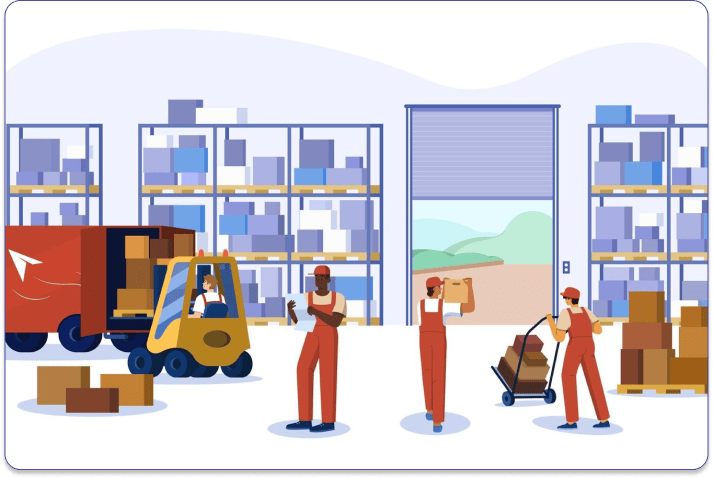Enhancing Warehouse Operations with Energy-Efficient Automation

Automation is transforming the operational workflow across various industries and improving productivity and precision. Learn how your warehouse operations can be streamlined with energy-efficient automation.
The globalization of supply chains has added additional challenges to warehouse management, forcing businesses to look for smarter solutions to remain competitive and relevant. Sustainable warehouse automation was developed as a comprehensive approach to address these challenges and successfully handle the complexity of contemporary supply chains. However, reducing the negative effects of warehousing operations on the environment requires energy efficiency.
Warehouses can make a major contribution to building a more sustainable future by optimizing their energy usage. In order to reduce the overall environmental impact, energy-efficient practices must be implemented in warehouses, which have high energy consumption due to large indoor spaces, heavy equipment usage, and 24/7 operations. This article discusses sustainable warehouse practices through energy-efficient automation. Continue reading to learn more!
What is Warehouse Automation?
The process of automating warehouse operations such as inventory management, data entry, and product packaging with the use of AI tools, machines, and robots is known as warehouse automation. As part of an automation project, a business can eliminate labor-intensive tasks or delegate repetitive and non-core tasks to AI and focus on the more important work to enhance productivity.
Warehouse automation offers many benefits, from optimized workflow and reduced costs to access to important data for proactive decision-making. In several warehouses, AI tools also help transport packaged goods from warehouses to delivery areas, reducing the need for human labor.
The Importance of Moving Towards Green Warehouse Management
The application of sustainable practices in the warehousing and logistics industry is known as green warehousing or green warehouse management. It includes a broad range of tasks, such as cutting down on waste and energy use, improving supply chain transparency, and optimizing resource usage. According to a recent Allied Market Research study, the global market for green logistics is projected to grow at an annual growth rate of 8.3% between 2023 and 2032, reaching $2.9 trillion. This data shows the rising importance of introducing energy efficiency throughout the supply chain, including warehouse operations.
The goal is to lessen the negative effects of warehousing operations on the environment while simultaneously generating financial gains from increased productivity and lower expenses. The use of energy-saving technologies and solutions is now essential to reaching these environmental goals. Here are the benefits of improving energy efficiency in your warehouse:
- Cost savings: You’ll start to notice savings on your bills when you choose equipment that increases warehouse energy efficiency and implement systems that help you use your resources more wisely and cut down on waste. These savings can be used to expand your operations.
- Reduce your environmental footprint: Companies nowadays are making an effort to increase their awareness of their environmental footprint or the impact of logistics on the environment. Thus, these businesses become more sustainable by measuring their carbon footprint and adopting strategies to reduce it, increasing the energy efficiency of the warehouse.
- Make your business more competitive: In addition to providing better services, competitive businesses also apply simple solutions for intricate problems to increase the energy efficiency of the warehouses where they keep their inventory. Furthermore, with consumers increasingly valuing environmentally friendly products and services, businesses that focus on green warehouse management can gain a competitive edge.
Leverage Sustainable Automation For Streamlined Warehouse Practices
While warehouse management can be a costly and energy-costly process, you can implement energy-efficient automation strategies to make it more sustainable. Here are some tips for using sustainable warehouse automation to enhance operations and create sustainability:
- Implement energy-efficient technologies
The incorporation of energy-saving technologies is a key focus of sustainable warehouse management solutions. Warehouses and distribution centers can easily and affordably maintain their energy efficiency through the use of IoT and AI-powered tools like automated lighting sensors, robots, and warehouse assistance systems. The latter can help in optimizing temperature, use motion detection to switch off appliances not in use, and streamline the overall warehouse management.
- Purchase of modern equipment
Another important feature of warehouse automation that offers sustainable solutions is waste management. Waste reduction is a comprehensive strategy that addresses the entire supply chain, not just recycling initiatives. Modern automated warehouse management systems include features that promote inventory accuracy and optimization, thereby minimizing waste. These machines may have a longer useful life, ensuring you will also save money on replacement costs as you will ultimately save on energy consumption.
- Enhanced transparency and sustainability reporting
Regular inspections of the warehouse are essential since they enable you to determine the general state of the property as well as the state of your storage equipment. If you want to increase the energy efficiency of your warehouses, automated warehouse management softwares can help you acquire real-time data on a variety of metrics, including carbon emissions, energy consumption, and waste reduction. This data can be used to measure the sustainability score of your overall processes as well as effective resource management and how to streamline operations.
Final Words
Green warehouse management is a paradigm shift in the logistics and warehouse automation industry toward environmentally friendly and sustainable practices. Warehouses can lessen their environmental impact while also increasing operational effectiveness and customer trust by implementing sustainable automation solutions, integrating modern technology for improved transparency and traceability, and adopting energy-saving technologies. In addition to being a responsible business decision, adopting these practices is an essential step in toward a more sustainable future for everyone.
Are you looking for sustainable and streamlined automation solutions for the optimization of the warehouse processes? Nomadia offers robust and energy-efficient solutions for every segment of your supply chain and logistics, from warehouse to delivery of goods. Request a demo with Nomadia today and take the first step towards sustainable warehouse practices.
